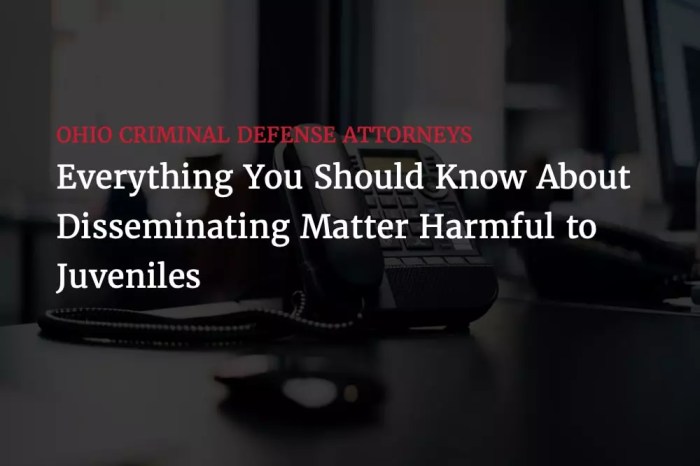Disseminating matter harmful to juveniles examples – Disseminating Matter Harmful to Juveniles: Examples and Consequences explores the distribution of content that meets the definition of disseminating harmful matter to juveniles, providing real-world scenarios, examining various channels used for dissemination, and analyzing their effectiveness among young audiences. The legal and ethical implications of distributing such content are thoroughly discussed, along with strategies for prevention and education.
Examples of Disseminating Matter Harmful to Juveniles

Disseminating matter harmful to juveniles encompasses a wide range of content that poses a significant threat to young people’s physical, emotional, and psychological well-being. These include:
- Distribution of sexually explicit material to minors through online platforms, social media, or physical distribution channels.
- Sale or distribution of drugs, alcohol, or tobacco products to minors, both online and offline.
- Cyberbullying, online harassment, and other forms of digital abuse directed towards young people.
- Promoting or glorifying violence, hate speech, or other harmful ideologies that can incite hatred or violence among minors.
- Encouraging or facilitating self-harm, suicide, or other dangerous behaviors among young people.
The legal and ethical implications of disseminating such content are severe, as it violates the rights of children and adolescents to safety, protection, and healthy development.
Methods of Dissemination

Harmful content is disseminated to minors through various channels and platforms, including:
- Online platforms:Social media, messaging apps, online forums, and websites can provide anonymity and easy access to harmful content for minors.
- Physical distribution:Printed materials, DVDs, and other physical media can still be used to distribute harmful content, especially in areas with limited internet access.
- Peer-to-peer networks:File-sharing platforms and other peer-to-peer networks can facilitate the distribution of harmful content among young people.
- Dark web:The dark web provides a hidden platform for the distribution of illegal and harmful content, including material that targets minors.
The effectiveness of these methods varies depending on the target audience, the nature of the content, and the level of monitoring and enforcement in place.
Procedures for Identifying Harmful Content

Identifying harmful content for juveniles requires a multi-faceted approach that includes:
- Criteria for harmful content:Establishing clear criteria for determining what constitutes harmful content for minors, based on factors such as age appropriateness, potential for harm, and legal definitions.
- Monitoring and identification:Implementing automated and manual monitoring systems to identify and flag potentially harmful content online and offline.
- Collaboration and reporting:Encouraging young people, parents, educators, and other stakeholders to report harmful content to authorities and platform moderators.
- Content analysis:Using advanced content analysis techniques to identify patterns, themes, and potential risks associated with harmful content.
These procedures help to ensure that harmful content is identified and removed promptly to protect young people from exposure.
Strategies for Prevention: Disseminating Matter Harmful To Juveniles Examples
Preventing the dissemination of harmful matter to juveniles requires a comprehensive plan that involves:
- Education and awareness:Raising awareness among young people, parents, and educators about the dangers of harmful content and how to identify and avoid it.
- Parental controls and monitoring:Providing parents with tools and resources to monitor their children’s online activities and restrict access to harmful content.
- Platform regulation:Holding online platforms accountable for preventing the dissemination of harmful content by implementing strict moderation policies and age verification measures.
- Law enforcement and prosecution:Enforcing existing laws and regulations against the distribution of harmful matter to juveniles and prosecuting offenders.
- Collaboration and partnerships:Fostering collaboration among stakeholders, including law enforcement, educators, parents, and technology companies, to develop and implement effective prevention strategies.
By implementing these strategies, we can create a safer environment for young people online and offline.
Query Resolution
What constitutes harmful content for juveniles?
Harmful content for juveniles includes material that is obscene, pornographic, violent, or that incites hatred or violence against children.
What are the legal consequences of disseminating harmful matter to juveniles?
The legal consequences vary depending on the jurisdiction but may include fines, imprisonment, or both.